
この自然の肌触りは簡単にはまねできません。伊豆で。
Flakey bark in a wet climate ages with moss. In Izu.

最近、クスノキという巨大な木について知りました。中伊豆で見たものは、幹に苔がいっぱい生えていました。東京のオフィス・タワーの前にも、もっと乾燥したクスノキを見つけました。とても素敵だと思います。
I recently noticed this giant evergreen tree called camphor (or kusunoki in Japanese). A single, well cared for tree can easily become a local landmark. The above tree is in a mountaineous area of Izu. Below in front of a glass and metal tower in Shiba, across from Tokyo Tower.


この素敵な盆栽はOmotesando Koffeeのオーナが作った作品です。コケが特に元気そうです。表参道に来た時はいつもこの美味しいコーヒーを飲んで、昭和モダンふうのインテリアと庭を楽しみながら、バリスタと話して行きます。
This beautiful bonsai was decorating the very chic Omotesando Koffee shop. The cafe is a modern cube inside a Showa house with a cozy front garden. The very cheerful barista explained that the owner made this bonsai himself. I like how the bonsai looks next to the cappuccino and the aged wood of the house and cupboard. The moss is especially lush and lovely.

冬の日光は、室内で植物を撮影するのにいいと思います。
ベランダの庭には、植木鉢が多いです。ですから、室内に持って来るのが簡単です。一つの植物はお客さんを接待するときに使えますし、気分を変えてくれます。盆栽は一番持ち運びがよくて、いくつかの要素が小さな世界を作ってくれます。
The winter sunlight is particularly good for indoor plant portrait photography.
Bonsais are the ultimate in portable and creating an entire, changing world with few elements. Part of gardening involves the overall effect of dozens or hundreds of plants. But part is also the specific plant and season.
As a balcony gardener using containers, I have many small plants that are especially portable. A single indoor plant can welcome a guest or create a mood.

みんなは小さいなベランダに100種類 以上の植物があると聞いて、驚いています。このクローズアップの中に、盆栽が三個、多肉植物が二個、それからミントもあります。スペースが小さいけれど、可能性は大きいです。
People are surprised when I tell them that I have at least one hundred plants on my small Tokyo balcony. It sounds like a lot, but actually it’s easy to accumulate. Even a small garden can have many layers. I was aiming my camera at the fairly large bonsai in the center, made by my friend Matthew. It has two types of grasses, two types of mosses, and a fern. Some neighboring mint is stretching above that singularly planned assemblage. And at the bottom left are two small succulents in a flowerpot with drawings from my mother-in/out-law. There’s also a trunk and leaf from two neighboring bonsais. That’s at least ten plants in this one close-up.

I gave a minor trim to the kaede maple bonsai I made at Sinajina. It looks healthy. And the moss is even blooming. It’s now ready for fall.
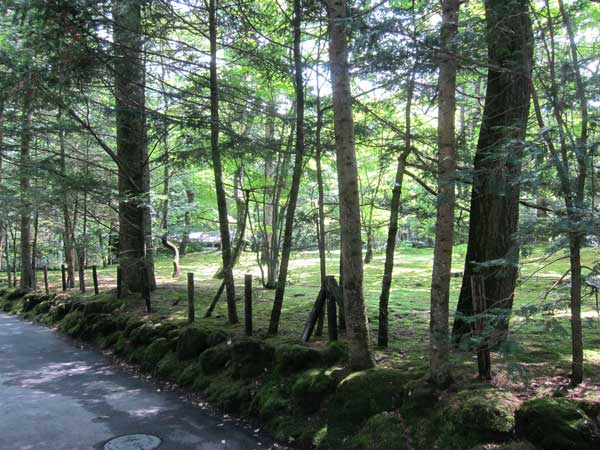
夏の軽井沢は涼しいです。自転車でまわって、苔の森や小川や池を見ました。東京から日帰りでも楽しいです。ジョンレノンとヨーコオノがよくたずねた喫茶店を見つけました。
In the heat of summer, Karuizawa remains cool and elegant. We found a moss forest, streams, and a small lake. It is just an hour from Tokyo by bullet train, and easy to rent a bike near the station. We passed many tennis courts, but did not meet any royalty. By accident, we met the charming proprietress of a coffee shop frequented by John Lennon and Yoko Ono in 1977.
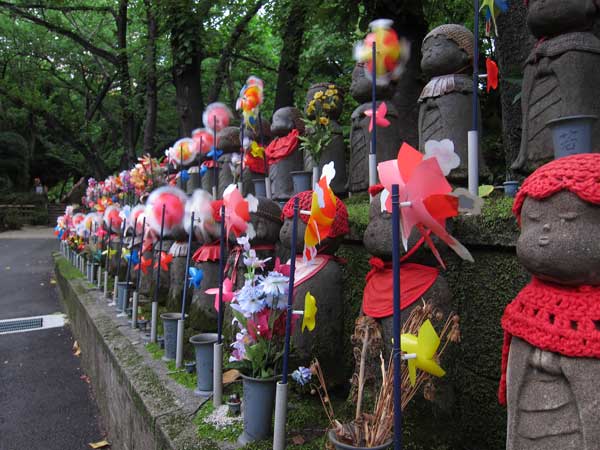
三解脱門にお地蔵様が千くらいいます。お盆なので、新しい帽子や前掛けや風車を持っています。風車はみんなお地蔵様のほうを向いています。面白いと思います。
There must be hundreds or even a thousand ojizosamas at Sangendatsu-mon temple in Shiba-koen. Maybe because of summer obon, a time to communicate with the deceased, that they have fresh hats, bibs, and colorful plastic pinwheels. I love how all the pinwheels are pointed at the statues and not the people who walk by them. Close to Tokyo Tower, the parks and temples have wonderful mature trees and moss.

この盆栽の葉を見たとき、うれしかった。もう死んじゃったかと思いました。
I have lost a number of bonsai over the past two years. It was a pleasant surprise to see these little leaves appear. I need to replace the moss.

Sinajina, the modern bonsai shop in Jiyugaoka, always has beautiful small bonsai inside with a focus on seasonal plants and flowers. Outside the shop, there are always rows and rows of plants that can be used for bonsais or landscaping. There are also some larger plants, like the tree above that is growing out of a giant mound of moss.
Sinajina always has amazing moss, and Kobayashi Kenji sensei and his staff are very skilled at combining the moss to look like a single piece. The moss is always gorgeous in the small bonsai, but this large one is spectacular.
Below is a shot of some of the unstaged inventory, including a pine with a miniature rope sculpture like the ones used in winter to prevent damage from snow that are typical in traditional Japanese gardens.


Recently I had the pleasure of attending my second bonsai-making class with Kobayashi Kenji sensei at Sinajina. While last fall’s class focused on black pine, this time we made a miniature landscape with three gangly deciduous shrubs (Nanking nanakama) and a small flowering astilbe (tannachidakesashi). At the base, we added moss and gravel.
I like how this small combination includes different heights and forms, flowers, and leaves that turn color and drop in the fall. It should be fun to take care of it in different seasons. In addition to TEDxSeeds organizers, the class also included three sisters from Tochigi who come to five classes every year. They clearly were more advanced than us beginners!

I highly encourage anyone to take a class at Sinajina. They are offered several times per month. For basically the cost of the plant (about US $70 or 6,500 yen), you not only leave with a bonsai you have made yourself, but you also learn from Kobayashi sensei about the plants, how to arrange them, and his passion about how people and plants can live together. For now, classes are in Japanese, but recently Kobayashi sensei hired a bilingual American and may soon offer classes in English.


I have had the pleasure of visiting Sinajina three times in the past three weeks: to talk with Kobayashi sensei about a project with the Portland Japanese Garden, to take a class with TEDxSeeds organizers, and to visit with my Newsweek Japan editor. In every visit, the store is set up differently, and the most seasonal bonsai are most prominently displayed.
Last weekend, the rose and mountain hydrangea perfectly capture the turning of the season from late spring to early summer. These bonsai are perfect in shape, buds just opening, and contrast with pot, gravel, and moss.
I also like the contrast between these plants and the hollyhocks I featured yesterday. All of them are seasonal flowers, yet they differ in scale and degree of human care. I like to think that urban nature extends from the wild and unruly to the groomed and domesticated.
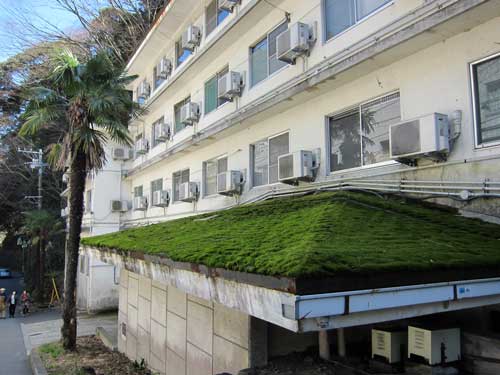
On a Nodai Garden Laboratory trip organized by Hattori sensei, I visited some amazing gardens and shrines, and stayed at a beautiful ryokan called Yoshiike. What I did not expect to see were these incredible moss roofs and walls in unexpected places.
While I love designed gardens, I am also amazed at how nature can impose itself on our built environment, creating beauty in unlikely places. I like the idea of the garden extending itself into the everyday.

Even mundane structures come alive when we let nature colonize our habitat.


My friend Endo Masahiro’s Sodateck has developed a combination LED and fluorescent grow light system for Japan. By combining the two light sources, Sodateck offers an optimal spectrum for plants. I like how his product catalog, in print and web, shows indoor gardening in a very contemporary setting: edibles and decorative plants in a chic wood and stone house with bicycles and other signifiers of modern style and living.
Based in Tokushima, Shikoku, he recently exhibited his indoor gardening system at the Gardex (International Garden Expo Tokyo). It was great to see the full range of what he is creating.

The systems are very elegant: brushed steel with two buttons, one for each light source type. Endo-san also brought some of his indoor plant creations, including modern bonsais like this moss on black stone tray. It seems clear that Endo-san is influenced by his friendship with modern bonsai master Kobayashi Kenji (小林健二) of Sinajina (品品).

Click the link below to see some more photos of his products, including hydroponic systems with his business partner Yakumo Trading.
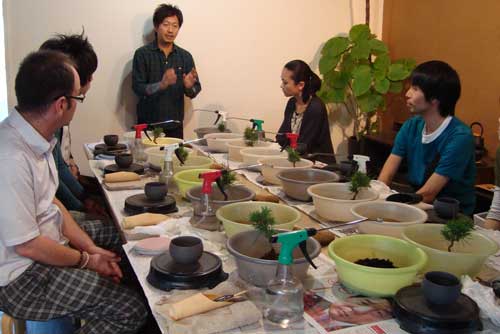
Recently I had the pleasure of taking Kobayashi Kenji’s modern bonsai class at Sinajina. In addition to making my own miniature landscape with a black pine, rock and moss, I learned that gardening in October is focused on making plants beautiful for New Year’s celebrations and guests.
The class used eight year old black pine trees. First we removed all the old, longer pine needles by hand and with tweezers. We removed nearly all the old soil to replace it with a fresh mix that includes volcanic rock and to expose some of the oldest roots at the base of the trunk. Then, we examined the tree to identify its “face” and position the tree in its new pot. Finally we added moss– in my case a taller hill that passes underneath one of the roots and a lower meadow– and small rocks.
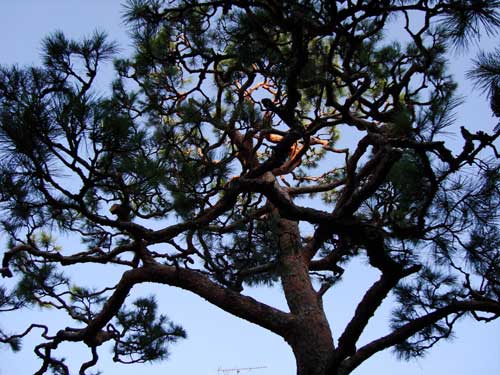
Careful attention to form and style is clearly something that extends from miniature landscapes to residential garden landscapes. I am sure that many home-owners and gardeners are pruning their trees now to make sure that they are spectacular at New Year.
I also learned how to distinguish between black pine and red pine. Black pine needles are hard, unbending and sharp, while red pine needles are much softer to touch. Only when fully mature do red pine trees exhibit the bright red trunk that also distinguishes them. Black pine trees are mostly found near the sea, whereas red pine trees grow in the mountains.
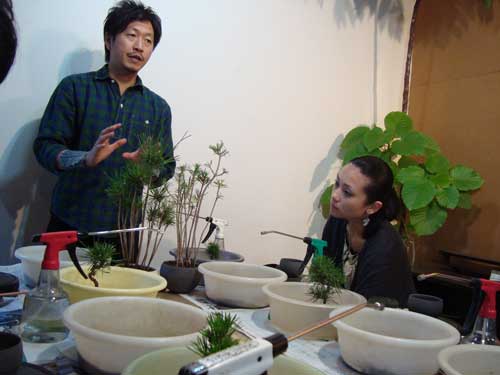
Kobayashi sensei continues to be an inspiring guide to plants in urban life. In his anthropomorphism, plants become more human, and humans more embedded in nature. Plants are like people, he explains, in that they require most care during their first year, including more water. Once domesticated, plants cannot be returned to the wild since they have lost their survival skills and require continued human care.